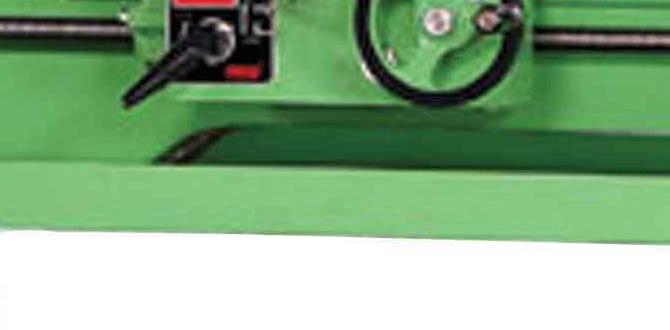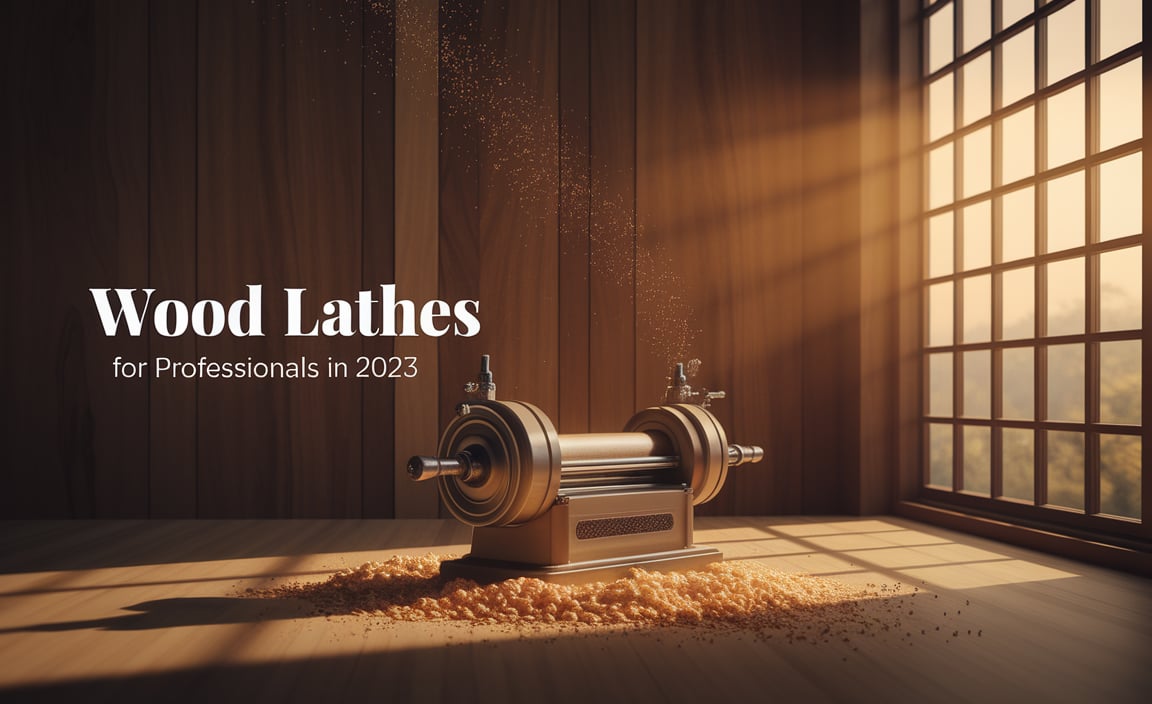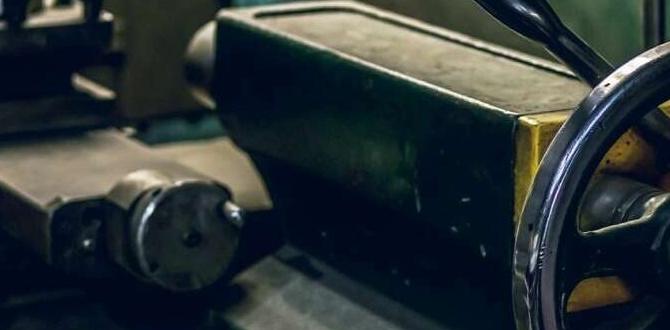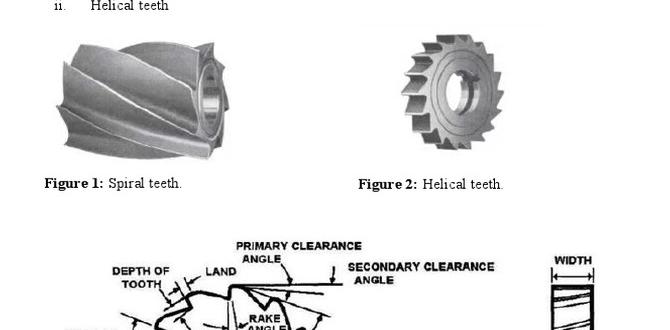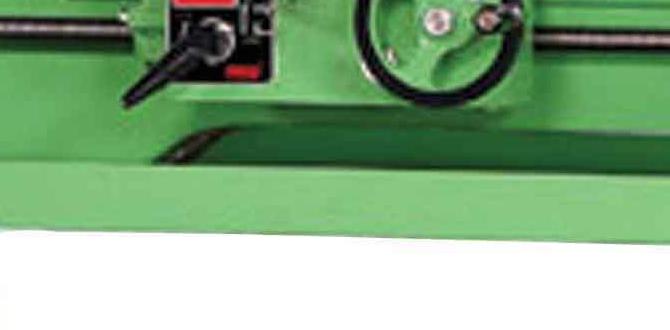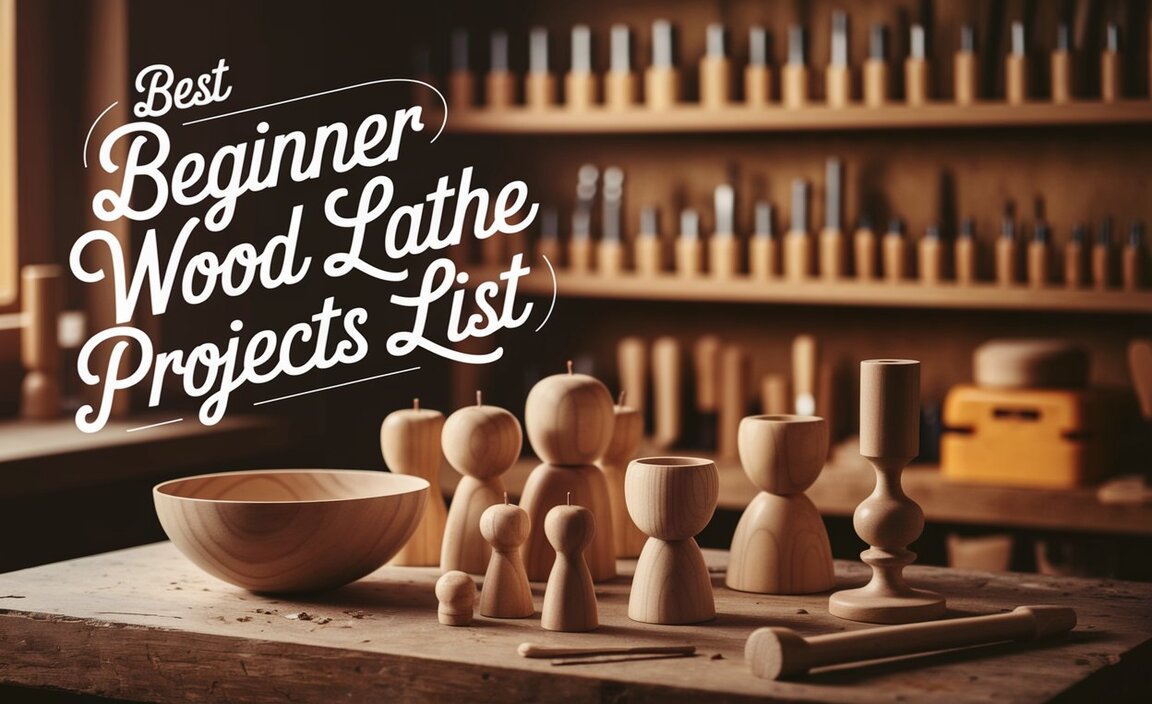Quick Summary: Equipping your premium CNC lathe with the right tooling unlocks its full potential. Essential tooling includes high-quality cutting inserts, tool holders, collets, live tooling, and measuring tools. Investing in proper gear ensures precision, efficiency, and superior finished parts.
Welcome to Lathe Hub! If you’ve just invested in a premium CNC lathe, you’re probably excited to start creating amazing projects. But here’s a common little hurdle: knowing exactly what “bits” and “holders” your shiny new machine needs to perform its best. It can feel a bit overwhelming at first, right? Don’t worry! I’m Daniel Bates, and I love making machining simple. We’ll walk through the essential tooling step-by-step, so you can get turning with confidence. We’ll cover everything from the tiny cutting tips to the bits that hold them firmly in place.
Choosing Your CNC Lathe’s Essential Tooling
Your premium CNC lathe isn’t just a fancy piece of metal; it’s a precision instrument. To make it sing, you need the right tools. Think of it like a chef needing sharp knives and precise measuring cups. For machinists, the tooling is just as critical for turning raw material into beautiful, functional parts. Getting this wrong can lead to poor finish quality, inaccurate dimensions, broken tools, or even damage to your lathe. But getting it right? That’s where the magic happens! Your projects will be smoother, faster, and more professional. Let’s break down the must-have items.
1. Cutting Inserts: The Sharp End of the Stick
These are the workhorses of your CNC lathe. Cutting inserts are small, often indexable pieces of extremely hard material that actually shear away the metal. They come in many shapes, sizes, and materials, each designed for specific tasks and materials you’ll be cutting, like steel, aluminum, or plastics. For a beginner with a premium CNC lathe, focusing on a few versatile types is key.
Understanding Insert Types and Materials
The main things to consider with inserts are their shape and the material they’re made from.
Insert Shapes:
- Triangular (T-Max): Good for general-purpose turning and facing.
- Square (CNMG, SNMG): Excellent for heavy roughing and facing operations.
- Rhombic (DCMT, RCMT): Versatile for turning, profiling, and facing.
- Round (CNMP, RNMP): Used for profiling and situations where sharp corners aren’t needed.
Insert Materials:
- Carbide: The most common. Great for steels, cast irons, and some non-ferrous metals. It’s hard but can be brittle.
- High-Speed Steel (HSS): Less common for CNC inserts but good for some soft metals or very specific applications. More forgiving than carbide but wears faster.
- Ceramic: Extremely hard, good for high-speed machining of very hard materials. Very brittle.
- Cubic Boron Nitride (CBN) and Polycrystalline Diamond (PCD): For specialized, very hard or abrasive materials. Often overkill for beginners.
Coating: Inserts are often coated (e.g., TiN, TiAlN, AlTiN) to improve hardness, reduce friction, and dissipate heat, allowing for faster cutting speeds and longer tool life. For general use, a PVD (Physical Vapor Deposition) coated carbide insert is a great starting point.
Pro Tip: Always check your machine’s manual or the tooling manufacturer’s recommendations for the best insert grade and geometry for the materials you plan to machine.
Where to Buy Quality Inserts
When you’re starting, it’s tempting to grab the cheapest inserts. But with a premium lathe, you want quality. Brands like Sandvik Coromant, Kennametal, Iscar, and Mitsubishi Materials are top-tier. For beginners, you can often find excellent starter packs or general-purpose inserts from these brands or their reputable distributors. Even some well-regarded, more budget-friendly brands offer good value if you stick to standard insert geometries.
2. Tool Holders: The Strong Grip
The insert needs something to hold it! Tool holders are the components that clamp the cutting insert and mount to your lathe’s turret or tool post. They transfer the cutting forces from the insert to the machine and ensure the insert is held rigidly. The type of tool holder you need depends on your lathe’s configuration.
The Main Types of Tool Holders
There are two primary systems for holding tools on most CNC lathes:
- VDI (Vergolder’s Direct Interface): A popular system for faster tool changes. The tool holder itself locks directly into the turret. You’ll see VDI sizes like VDI 15, VDI 30, etc., indicating the shank diameter.
- BMT (Basic Machine Tool): Another robust system, often found on larger or more heavy-duty machines. Tools are bolted directly to a flange on the turret.
- Manual/Standard Tool Posts: For smaller or older machines, you might use a traditional tool post where tools are held in block-style holders and clamped down. Premium CNC lathes usually have VDI or BMT.
Within these systems, you’ll have specific holders:
- Turning Holders: For external diameter turning. These usually hold triangular or square inserts for straight turning.
- Boring Bar Holders: For internal diameter boring. These are often tubular and hold round shank cutters or inserts for internal work.
- Threading Holders: Specifically designed to hold inserts for cutting external and internal threads.
- Grooving Holders: For cutting narrow grooves.
- Parting-Off (Cut-off) Holders: Designed to hold wide, robust inserts for cutting finished parts off the stock. These need to be very rigid.
Choosing the Right Size and Type
This is crucial! You MUST match the tool holder system (VDI, BMT, etc.) and size to your lathe’s turret. Using the wrong holder won’t work, can damage your turret, and is a major safety hazard. Your lathe’s manual will specify the required VDI or BMT size. For inserts, you need holders that accommodate the specific insert size and shape you choose (e.g., a holder for 3.175mm (1/8″) or 6.35mm (1/4″) TP(G) inserts, which is common for TPG or TNMG inserts).
3. Collets and Collet Chucks: For Precision Workholding
While your CNC lathe likely has powerful jaws for holding larger workpieces, for smaller diameters or when extreme precision is needed, collets are the way to go. Collets are like precision sleeves that grip a workpiece or a tool shank with immense accuracy and force. They are typically used in a collet chuck, which is a device mounted in the lathe’s spindle that actuates the collet.
Understanding Collet Systems
There are several collet systems, but for CNC lathes, you’ll commonly encounter:
- ER Collets: The most versatile and widely used system. ER collets come in various sizes (ER-8, ER-11, ER-16, ER-20, ER-25, ER-32, ER-40), with the number indicating the diameter range they can grip. ER collets are used in an ER collet chuck. They are excellent for holding tool shanks (like drill bits or end mills if you have live tooling) or small diameter bar stock.
- 3J, 5C Collets: More traditional systems, often found on manual lathes but sometimes adapted for CNC. They offer good accuracy but are generally less versatile than ER systems for high-volume CNC work.
- Custom Collets: For very specific or odd-sized workpieces, custom collets can be made, but this is usually for production runs.
When to Use Collets
Collets are perfect for:
- Holding bar stock for shaft turning jobs where concentricity is critical.
- Gripping smaller diameter workpieces that might get crushed or distorted by lathe chuck jaws.
- Reducing runout (wobble) for high-precision turning.
- Holding tools in a live tooling setup (explained next).
Important Note: A collet chuck needs to be mounted in your lathe’s spindle. You then insert the correct collet into the chuck, and tightening the chuck’s mechanism closes the collet around your workpiece (or tool). Make sure you get the right size collet for your stock and a collet chuck that fits your spindle nose.
4. Live Tooling: Adding Milling Power
Many premium CNC lathes come equipped with, or can be fitted with, “live tooling.” This is a game-changer! Instead of just rotating the workpiece, live tooling allows you to mount tools that rotate themselves. This means you can perform milling operations (like slots, flats, or cross-holes), drilling off-center, or even tapping operations directly on the part while it’s still held in the lathe.
Types of Live Tooling
Live tooling holders look similar to standard VDI/BMT holders but contain a geared mechanism or a direct drive interface that connects to your lathe’s spindle or a separate drive motor. Common types include:
- Live Milling Spindles: These are driven externally (often by the same motor that powers the main spindle) and rotate an attached tool, like an end mill.
- Live Drilling Spindles: Similar to milling spindles but designed for optimal speed and torque for drilling operations.
- Live Tapping Spindles: Equipped with special holders that allow for synchronized tapping, which is crucial for accurate thread depth and eliminating tap breakage.
- Live Rotary Tools: These can hold smaller, high-speed rotating tools like engraving or grinding bits.
Benefits of Live Tooling
- Reduced Setups: Mill features, drill holes, and tap threads without moving the part to a milling machine. This saves immense time and reduces errors.
- Increased Accuracy: Features milled or drilled with live tooling are perfectly concentric with the turned/bored features because the workpiece doesn’t move.
- Complex Parts: Enables the creation of much more complex parts in a single machine.
Consideration: Live tooling can be an added expense, so assess if your project needs justify it. However, for a premium CNC lathe, it’s often a key feature that unlocks significant capability.
5. Measuring and Inspection Tools: Ensuring Accuracy
Even with the best lathe and tooling, you need to measure your work to ensure it’s right. Investing in accurate measuring tools is non-negotiable for any serious machinist.
Essential Measuring Tools
- Digital Calipers: Your go-to for quick, accurate outside and inside diameter measurements, as well as depth. A good quality digital caliper (e.g., Mitutoyo, Starrett, Fowler) is a must-have.
- Micrometers: For extremely precise external diameter measurements, especially on critical features. You’ll typically need a set of outside micrometers (e.g., 0-1 inch or 0-25mm, 1-2 inch or 25-50mm).
- Bore Gages/Inside Micrometers: For accurately measuring internal diameters.
- Height Gage: Useful for layout work and measuring height dimensions, especially when used with a surface plate.
- Dial Indicators/Test Indicators: Essential for checking concentricity, alignment, and runout of workpieces or fixtures.
Why Quality Matters Here
Cheap measuring tools might seem okay initially, but they can be inaccurate and lead to parts that are out of tolerance. This can result in scrap parts, failed assemblies, and frustration. For inspection, look for reputable brands known for their precision and durability. Remember to keep your measuring tools clean and protect them from chips and coolant.
6. Workholding: The Foundation of Your Part
While chucks are the most common workholding device on a lathe, understanding your options is key, especially with a premium machine. The way you hold your workpiece directly impacts accuracy, surface finish, and safety.
Common Workholding Devices
- 3-Jaw Chuck: The standard for round stock. It’s versatile and self-centering, making it quick to load. For premium lathes, consider a high-quality, precision chuck.
- 4-Jaw Chuck: Independent jaws allow you to grip irregular shapes or precisely center round stock if the spindle is true.
- Collet Chucks: As discussed, excellent for precise gripping of bar stock and smaller diameters.
- Dew-Point Systems: For very thin-walled or delicate parts that could be crushed by conventional methods. These use a vacuum or specialized gripping mechanisms.
- Custom Fixtures: For production runs or highly specialized parts, custom workholding solutions might be designed.
Safety First: Always ensure your workpiece is securely gripped. A workpiece coming loose from a spinning lathe is incredibly dangerous. Familiarize yourself with your machine’s workholding system and inspect it regularly.
General Tooling Considerations for Premium Lathes
When you have a premium CNC lathe, you want tooling that matches its capabilities. This often means:
- Higher Precision: Tooling with tighter tolerances contributes to better surface finish and dimensional accuracy.
- Enhanced Rigidity: Robust tool holders and shanks reduce vibration, allowing for heavier cuts and better finishes.
- Better Materials: Higher quality tool steels and carbides in holders and inserts mean longer tool life and faster cutting speeds.
- Ease of Use: Systems like VDI or good quality collet chucks can speed up tool changes, increasing efficiency.
Where to Learn More About Tooling
Reputable tooling manufacturers often have excellent online resources, including catalogs, selection guides, and application notes. For example, Sandvik Coromant’s website is a treasure trove of information on insert geometries, grades, and applications. Similarly, checking out resources from Kennametal can provide valuable insights.
| Tooling Category | Key Components | Primary Purpose | Beginner Focus |
|---|---|---|---|
| Cutting Inserts | Carbide, various shapes (triangular, square) | Shear material, create chips | General-purpose PVD coated carbide in common shapes (e.g., CNMG, DCMT). |
| Tool Holders | VDI/BMT specific holders, turning, boring, threading | Securely hold inserts, mount to turret | Holders matching your lathe’s turret system (VDI/BMT size) and the insert shapes chosen. |
| Collets & Collet Chucks | ER collets, collet chuck | Precise gripping of bar stock or tool shanks | ER collet system in appropriate size range for your stock. |
| Live Tooling | Live milling/drilling/tapping spindles | Perform milling, drilling, tapping operations | Consider if your projects require off-axis features; can be a significant upgrade. |
| Measuring Tools | Digital calipers, micrometers, dial indicators | Verify dimensions, check accuracy | Good quality digital calipers and a basic micrometer set. |
| Workholding | 3-jaw chuck, 4-jaw chuck, collet chuck | Securely hold workpiece during machining | Ensure your existing chuck is in good condition; collet chucks for precision. |
Frequently Asked Questions (FAQ)
Q1: What is the most important tooling for a beginner using a new CNC lathe?
Answer: For a beginner, excellent quality, general-purpose cutting inserts and the correct tool holders for your lathe’s turret system are the most critical. Accurate digital calipers are also essential for measuring your parts.
Q2: How do I know what size VDI or BMT tool holders I need?
Answer: Your CNC lathe’s manual will clearly state the specific VDI size (e.g., VDI 30, VDI 40) or BMT size (e.g., BMT 55, BMT 65) that your turret accepts. You must match your tool holders precisely to this specification.
Q3: Can I use regular drill bits or end mills in my CNC lathe?
Answer: Not directly. You

